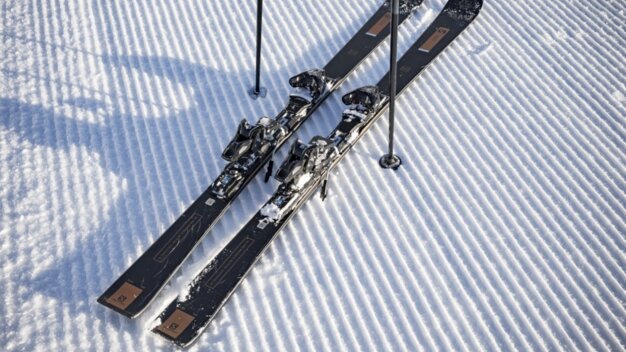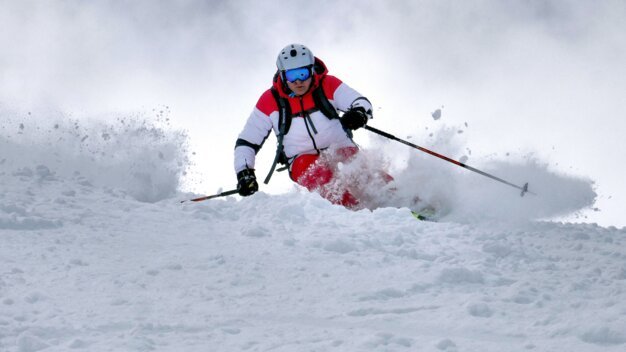
Anyone who has ever left the groomed slopes with their normal carving skis probably noticed rather quickly: This could be much more fun with the right pair of skis ... That's exactly why there are special freeride skis for off-piste skiing, which are designed for manoeuvring in powder snow. One thing up front: The motto for freeride skis is "The longer and wider the better!"
What is the ideal ski length for freeride skis?
Freeride skis are usually between 5 and 15 centimetres longer than your height.
This makes them considerably longer than standard carving skis for on-piste skiing. Why is that? Long skis offer a lot of stability, especially in deep powder snow and at high speeds. Off piste, these factors are more important than a low weight and good downhill performance. Freeride newbies are advised to start with skis that are suitable for their height. The more advanced their skill level, the longer the skis can be.
In addition, freeride skis are as wide as 95 to 140 millimetres. Another special feature are rockers on the front tips of the skis, but more on this below!
Tip: If you're planning to practice some tricks in the backcountry, you need freeride skis with a twin tip! They have a symmetrical shape, and the two ends of the ski (also called tip and tail) have the same dimensions. This means you can swoosh through powder snow both forwards and backwards.
Freeride ski lengths at a glance
This table should give you a basic idea of the perfect length for freeride skis. As always, this info serves as a rough guide!
| Height and weight of the skier | Recommended length for freeride skis |
| Height: 150-160 cm Weight: 45-55 kg |
155-165 cm |
| Height: 160-170 cm Weight: 55-65 kg |
165-175 cm |
| Height: 170-180 cm Weight: 65-75 kg |
175-185 cm |
| Height: 180-190 cm Weight: 75-85 kg |
185-190 cm |
What types of freeride skis are there?
Nowadays, there is a wide range of different types of skis for freeride skiers. The most important ones are fat skis/powder skis and all-mountain models. Which skis you choose primarily depends on their intended use. It's clear that you'll probably want to live it up in the backcountry – but there is more than just one type of snow. Your choice of skis also depends on the snow conditions and the type of terrain you want to ski in.
We will be happy to advise you on the right type of freeride skis for your needs when you visit us at our rental shops!
Good to know: Freeride skis can also be used as touring skis. However, remember that most downhill freeride skis are much heavier, meaning you'll have to lug more weight up the mountain!
Fat skis/powder skis
Fat skis are very wide – their waist is between 110 to 130 millimetres. This gives them an enormous radius of up to 30 metres, allowing you to practically "surf" on powder snow. They have terrific snow flotation!
We usually recommend fat skis to freeride newbies wanting to try out this discipline, as they make it much easier to venture out into the backcountry for the first time. But, since fat skis were specifically designed for powder snow, they're less suitable for hard slopes and rough terrain.
All-mountain freeride skis
All-mountain skis are quickly gaining in popularity. No wonder! They're suitable for every terrain and every route. All-mountain freeride skis are not quite as wide as fat skis, they have a waist between 85 to 110 millimetres. Those are dimensions that skiers can benefit from even on groomed ski runs, which is why more and more all-mountain models can be seen there.
What are rockers on freeride skis?
A rocker is the upward bend at the ends of a freeride ski. Depending on the model, the rocker is either at the front end (tip rocker), the rear (tail rocker) or along the entire ski (full rocker).
Depending on the skis' intended use, the rockers might be more or less pronounced. Skis with larger rockers are more nimble and provide amazing flotation in fresh snow. Conversely, pronounced rockers make manoeuvring more difficult on hard snow or groomed runs, so you probably wouldn't want to use them for carving.
Your personal skiing style determines whether the rockers should be bigger or smaller:
- for advanced skiers who like to go full speed: smaller rockers
- for relaxed freeriders with a leisurely skiing style: bigger rockers
INTERSPORT Rent Tip
Talk to a RENTertainer at one of the rental shops throughout Europe! The experts on site know exactly what to look out for when it comes to freeride skis.





